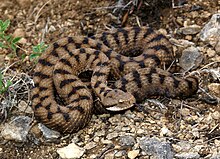Vipera aspis
The asp viper or asp (Vipera aspis) is a species of viper that can be found in Europe. Sometimes this name is wrongly attributed to other species of vipers, and even to any kind of poisonous snake.
Description
Adults are at least 60 cm long. Males reach up to 85 cm, and females a maximum of 75 cm. The males, however, are slightly slimmer than the females. The tail is relatively short, one seventh to one ninth of the body length in females, and one sixth to one eighth in males. The head is broad, triangular, and well differentiated from the neck. The scales of the body are greyish or yellow, golden or coppery, with black or greenish spots with a black border, in an apparent zigzag pattern on the back.
Habitat
Prefers warm areas with good sun exposure, structured vegetation, and relatively dry soils. In Italy and France, it is often found in montaneous or hilly areas, especially in limestone regions, but sometimes occurs on low plains. It has a preference for areas covered with vegetation or at least some cover. It can be found on sunny slopes over hills, swamps, mountain meadows, forest clearings, at forest edges, in garbage cans, and in the quarries. In Italy it is found in groves and often near fountains. Although it is not typical of elevated areas, in the Pyrenees it has been found above 2,600 meters above sea level, in the area of the Mulleres peak.
Poison
A bite from this species is very painful and can have more severe consequences than those of Vipera berus. According to Stemmler, about 4% of all untreated snakebites are fatal. Lombardi and Bianco (1974) mention that this species is responsible for 90% of all snakebite cases in Italy; in the Italian mountains it is the It is the only poisonous snake that can cause fatalities. In the event of a bite, it is highly advisable to visit a doctor to carry out the correct treatment, and if necessary, apply an antivenom (antophidic serum).
Venom toxicity varies. Stemmler indicates that the population in the Passwang district (Switzerland) has the strongest venom. Compared to the venoms of other species, it is relatively toxic. Brown (1973) gives LD50 values of 1.0 mg/kg IV and 1.0-2.0 mg/kg SC. Your et al. (1969) indicate 4.7 mg /kg IM. Venom production is relatively low. Boquet obtained a daily record of the extraction of 9 to 10 mg.
Symptoms of poisoning include the rapid onset of sharp pain, followed by edema and discoloration. Severe hemorrhagic necrosis can occur in the immediate hours. Vision can be seriously impaired, most likely due to the breakdown of blood and blood vessels in the eyes. The venom has coagulant and anticoagulant effects. The anticoagulant activity is apparently stronger than that of Daboia russelii.[ citation needed] The venom can also affect the glomerular structure and can lead to death due to kidney failure.
According to Cheymol et al. (1973), the venom does not produce neuromuscular contractions in in vitro preparations. The lack of this neurotoxin would indicate that fatal cases involving the cardiovascular system are the result of direct muscle injury or reduced oxygen exchange. On the other hand, González (1991) published that in two cases the victims developed neurotoxic symptoms, including difficulty in breathing and swallowing, as well as paralysis of the bitten limb.
Subspecies
| Subspecies | Authority | Common name | Distribution |
|---|---|---|---|
| V. a. aspis | Linnaeus, 1758 | European aspid | Parts of France; Pyrenees; Spain southwest of Bilbao; Germany, south of the Black Forest, northwest of Italy and west of Switzerland. |
| V. a. atra | Meisner, 1820 | Black ass | Parts of Switzerland. |
| V. a. francisciredi | Laurenti, 1768 | Aspid Italian | Central Italy. |
| V. a. hugyi | Schinz, 1833 | South | South of Italy. |
| V. a. zinnikeri | Kramer, 1958 | Say gasconous | Gascony, Andorra and northern Spain (Central Pyrenees). |
Contenido relacionado
Pigeons
Carcharhinus leucas
Arbutus

